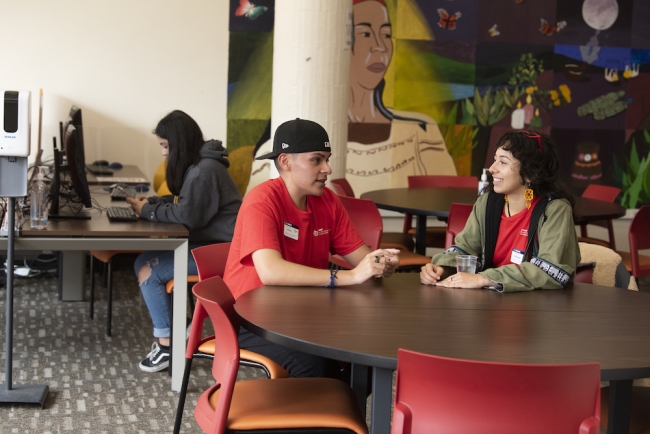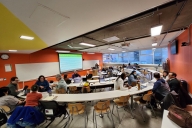You have /5 articles left.
Sign up for a free account or log in.

UC Davis’s Center for Chicanx and Latinx Academic Student Success provides table space and desktops for students to study, hang out or utilize academic services.
Center for Chicanx and Latinx Academic Student Success
Amarachi Ojukwu is one of 1,230 Black students attending the University of California, Davis—out of a total of just under 41,000.
On an average day, she said, she doesn’t typically run into other Black people around campus, which can feel isolating.
But she has somewhere to turn—the institution’s Center for African Diaspora Student Success, tucked away on the second floor of a dining facility, is always full of familiar faces. As a freshman, she studied a few times a week at the center—which houses academic services like advising and tutoring for select courses—as a requirement of a scholarship she’d received.
Now that the center has hired her as a student assistant, she is there daily. If she’s not working, she’s secure in her favorite spot: a beanbag chair that she said feels like a cloud. The center has become her home away from home—a place where she studies, chats with friends or just kills time between classes.
“I’m always there. Monday through Friday, you’ll find me at CADSS,” she said.
The CADSS is the oldest of UC Davis’s three identity-based academic retention centers, which merge traditional cultural centers with academic support offerings including tutoring and advising. The other two identity-based centers focus on supporting Native American and Latino students; a fourth center for Asian and Pacific Islander students—the largest population at UC Davis, with over 11,000 students—is in the works, with a goal to identify a location within the next year.
Each center grew out of an Academic Retention Initiative, programs aimed at providing marginalized students the resources and individualized support they needed to thrive academically and eventually earn their degrees.
To fulfill that mission, the academic retention centers not only provide students with a community space—which is typical of traditional cultural centers—but they also supply academic and counseling resources that students from minority groups feel comfortable using. Some students from marginalized populations have trouble working with advisers who come from a different background, according to Kat Parpana, who directs the Strategic Asian and Pacific Islander Retention Initiative; they may not understand the cultural context behind why a student can’t change their major from what their parents want them to study, for instance.
But in the academic retention centers, advisers who share the student’s identity are ready to help, or they can direct students to a departmental adviser who also shares that identity or is at least a trusted ally.
As CADSS director Dionica Bell puts it to her students, “If you go see my homie, I promise you will be treated with the dignity and respect you deserve.”
Ending Equity Gaps
Education advocates and leaders in California have long considered closing racial equity gaps—lower rates of college enrollment and degree attainment in minority populations—a top priority issue; in 2018, a coalition of institutions and organizations called for the state to close those gaps by 2030.
Beyond California, institutions and policy makers nationwide have been increasingly focused on developing approaches and plans to improve minority student outcomes. Efforts have included developing courseware to help such students in gateway courses, deploying grants to minority-serving institutions and providing targeted academic coaching.
UC Davis’s approach addresses the problem by identifying key academic support systems, such as tutoring and advising, that can be potential pitfalls for students of color who may face microaggressions, a lack of understanding or even overt racism from the individuals hired to provide those services. Rather than force students to simply put up with out-of-touch staff, it offers them another pathway.
Other institutions have launched academic centers that address specific populations; Queensborough Community College in New York features a resource center for Black and Latino men, for instance, and Washington University in St. Louis recently launched a center for low-income and first-generation students. But UC Davis’s centers are available to a majority of the campus population, since 62 percent of the institution’s students are nonwhite (not counting international students, which the institution lists as its own demographic category).
According to Parpana, students have been seeking out advisers who understand their experiences and background since before the inception of the centers. Ethnic studies advisers have a long history of working with students from other disciplines who had negative experiences with an adviser in their home department.
“Our partners over in the ethnic studies department … were originally doing a version of our work, and we as a campus had to acknowledge that that was too much labor on the folks that did that work,” Parpana said.
Two of those ethnic studies advisers became center directors: Bell and Rodrigo Bonilla, who heads the Center for Chicanx and Latinx Academic Student Success.
Lori Patton Davis, chair of the Department of Educational Studies at Ohio State University and a pre-eminent scholar of college campus diversity initiatives, said that the ethnic studies advisers’ experience mirrors a longtime trend at traditional campus cultural centers.
Staff members at those centers frequently serve as advocates and mediators for students of color who have felt mistreated or overlooked when seeking out campus services. But that was never the purpose of cultural centers; they were designed to serve as places where students can build community and explore and share their cultural identities. In some cases, establishing cultural centers has also exempted student affairs departments from conducting cultural programming, even for major holidays and celebrations like Black History Month, Patton Davis said.
“If you have this rush of students looking to the Black cultural center for these opportunities, that signals that [student affairs departments] … aren’t culturally responsive in the way students are seeking,” Patton Davis said. “It becomes a heavy load for an office to do these things, because they’re basically doing their work and the work of other offices on campus.”
UC Davis’s model seems to disrupt that trend, she said, by serving as a one-stop shop for a variety of student services, which they have enough resources and partnerships to do effectively—rather than become the backstop for other offices not pulling their weight.
Michelle Villegas-Frazier, the director of the Native American Academic Student Success Center, said that many traditional university cultural centers attempt to promote academic success, but those efforts end up being superficial.
UC Davis’s academic retention centers integrate identity-based programming “with academic success—not that many cultural centers don’t do that, [but] they do that in very light ways,” she said.
By dedicating resources, time and partnerships to academic support, as well as incorporating data to evaluate how well their efforts are promoting retention and degree completion, the centers at UC Davis have the potential to do more than cultural centers have achieved historically.
“We’re the next step. We’re the evolution,” Villegas-Frazier said.
Center Programming
In addition to advising, the centers also offer tutoring services for some select classes, as well as other academic, career-readiness and social programs. Though Parpana does not yet have a physical center to run, she organizes regular events for the university’s Asian and Pacific Islander students, including visits from alumni who frankly discuss the ways their identities affected their college experience.
“We have boba at almost every one of our events, and that is extremely culturally relevant,” she said.
Mental health counselors from the campus counseling center also routinely visit and provide services for the academic retention centers. Ojukwu, the CADSS student assistant, said this was the service she valued most; she connected with one Black counselor in particular, who she said no longer works out of the center but whom she sometimes visits in his office after getting to know him through his work in CADSS.
It was nice to have access to “someone who looks like me within that space [who] can actually help me,” she said.








